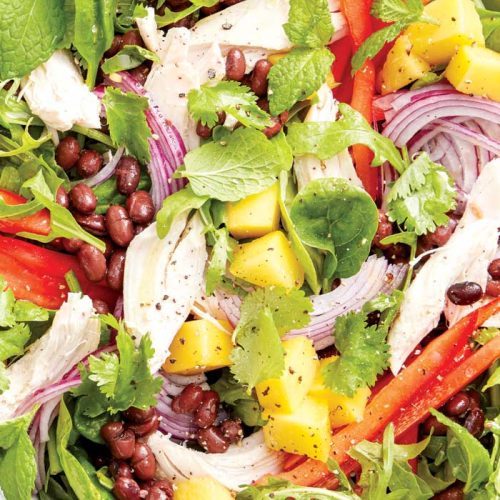
Do you love giving your cat or dog an extra treat to nibble on? As much as they seem to enjoy it, it isn’t always the healthiest move.
Just like humans, pets can suffer from weight issues. And it’s becoming a growing problem, with more chubby companion animals around than ever before. In a recent survey of veterinarians, 73 per cent said that obesity was “one of the most prevalent conditions” they see, with as many as half of pet dogs and 44 per cent of cats carrying excess bodyweight.
It’s a worrying trend. Although we can sometimes think that a chunky pet is cute, the reality is that even a little extra bodyweight can cause significant health issues for your pet – from diabetes to cardiorespiratory problems (such as trouble breathing when asleep) and even an increased chance of suffering from heatstroke.
Obesity – which is diagnosed when a pet is carrying 15 per cent-20 per cent more than their ideal body weight – is also associated with an increased incidence in conditions such as osteoarthritis and some forms of cancer.
It goes without saying that we all want our pets to live as long as possible. So here are some ways to keep your dog or cat in great shape.
1. Keep them active
Many dogs aren’t regularly exercised – sometimes because of poor weather, or perhaps because of behavioural concerns, such as anxiety when they encounter other dogs or people. And while outdoor cats generally keep themselves fit and active, indoor cats can have a level of body fat that is at least 5 per cent higher than outdoor cats, and are far more prone to obesity.
Exercise is key to maintaining a healthy body weight, and to weight loss too. Try to exercise your dog at least once a day, and ideally more. Take care to ensure the length and type of exercise is appropriate for their age and ability, and increase any exercise slowly.
Dogs love “scentwork” or “trick training” which can be done in your living room. And there are numerous cat toys to encourage your indoor feline companion to burn off some calories while engaging in play.
You could also make mealtimes more active by scatter feeding – where you scatter your dog’s food on the ground (after ensuring it’s clean and safe) – or puzzle feeders, which encourage your dog to work for food and treats.
Hydrotherapy, which involves getting your dog to swim or walk in a pool or water treadmill, can be a great option for gentle or non-weight-bearing exercise. This is especially true for older dogs or those recovering from injury.
Even cats can be trained to go for a walk on a lead. But if your feline friend simply won’t cooperate – or you don’t feel like braving the weather with your dog – you can try indoor or garden games to keep the activity levels up.
2. Watch their diet
Some pets simply enjoy their food so much that they can get a bit chubby whatever their age. Or, just like people, “middle-age spread” can occur in pets who may naturally slow down as they get older.
Either way, their diet may need to change to maintain a healthy bodyweight. Weight loss should be a gradual process, so always use recommended feeding guidelines on food packaging – or online calorie calculators – as a starting point for how much to feed your pet.
Try to keep a food diary every day. And, don’t forget to weigh out your pet’s food accurately using a scale. Scoops are hugely inaccurate and make overfeeding much more likely.
If their weight is far too high – or even approaching obese proportions – it may be best to begin your pet’s weight-loss journey with a trip to the vet for a full health check and body condition assessment. They will also be able to provide a target body weight and timeframe for weight loss.
3. Be aware of other risks
Sometimes it’s just in the genes. Some Labrador retrievers, for example, have a genetic mutation that predisposes them to increased “foodie” behaviour and weight gain. And neutered pets can have reduced daily calorie needs, so if their diet isn’t altered accordingly they can inadvertently gain weight.
So it’s important to recognise what a healthy bodyweight and shape is for your cat or dog – and the factors that could affect it. Do trust vets and other professionals, to make it easier for them to have potentially senstitive conversations with you about how best to help your pet lose weight.
4. Ditch high-calorie treats
High-fat food and treats provide lots of calories in small amounts, so it can be easy to overfeed your pet without realising. And fattening “human” food, such as leftovers, can also contribute to them piling on the pounds, alongside an increased risk of pancreatitis – and potentially even worse if toxic foods, including onions and some artificial sweeteners are ingested.
But managing your pet’s weight doesn’t mean you can’t treat them. Take a trip to your local pet shop to look for healthy low-calorie alternatives.
Or take a look in your fridge. Many dogs love carrot or cucumber, especially when chopped up as a training treat. Cats love a bit of tuna or chicken, both of which are high in protein but low in calories.
Don’t forget to look at other ways of treating your pet too – exercise, play and simply spending time with them will benefit both animal and human alike.
All of the tips do require a little effort. But keeping your pet’s body lean and healthy will help to prolong their life. And who among us doesn’t want longer with our beloved pets?![]()
This article is republished from The Conversation under a Creative Commons license. Read the original article.
You might also be interested in:
Article sources and references
- Alexander J. German, The Growing Problem of Obesity in Dogs and Cats, The Journal of Nutrition, Volume 136, Issue 7, 1 July 2006, Pages 1940S–1946S, https://doi.org/10.1093/jn/136.7.1940Shttps://academic.oup.com/jn/article/136/7/1940S/4664725
- PFMA. Pet Obesity Ten Years On - 2009 – 2019https://www.pfma.org.uk/_assets/docs/White%20Papers/PFMA-Obesity-Report-2019.pdf
- Jacquie S. Rand, Linda M. Fleeman, Heidi A. Farrow, Delisa J. Appleton, Rose Lederer, Canine and Feline Diabetes Mellitus: Nature or Nurture?, The Journal of Nutrition, Volume 134, Issue 8, August 2004, Pages 2072S–2080S, https://doi.org/10.1093/jn/134.8.2072Shttps://academic.oup.com/jn/article/134/8/2072S/4688883
- Hall, E.J., Carter, A.J. & O’Neill, D.G. Incidence and risk factors for heat-related illness (heatstroke) in UK dogs under primary veterinary care in 2016. Sci Rep 10, 9128 (2020). https://doi.org/10.1038/s41598-020-66015-8https://www.nature.com/articles/s41598-020-66015-8
- Hall EJ, Carter AJ, Farnworth MJ. Exploring Owner Perceptions of the Impacts of Seasonal Weather Variations on Canine Activity and Potential Consequences for Human–Canine Relationships. Animals. 2021; 11(11):3302. https://doi.org/10.3390/ani11113302https://www.mdpi.com/2076-2615/11/11/3302
- Westgarth, C., Christian, H.E. & Christley, R.M. Factors associated with daily walking of dogs. BMC Vet Res 11, 116 (2015). https://doi.org/10.1186/s12917-015-0434-5https://link.springer.com/article/10.1186/s12917-015-0434-5
- Cline MG, Witzel AL, Moyers TD, Kirk CA. Body composition of lean outdoor intact cats vs lean indoor neutered cats using dual-energy x-ray absorptiometry. Journal of Feline Medicine and Surgery. 2019;21(6):459-464. doi:10.1177/1098612X18780872https://doi.org/10.1177/1098612X18780872
- Dantas LM, Delgado MM, Johnson I, Buffington CT. Food puzzles for cats: Feeding for physical and emotional wellbeing. Journal of Feline Medicine and Surgery. 2016;18(9):723-732. doi:10.1177/1098612X16643753https://doi.org/10.1177/1098612X16643753
- Wallis N, Raffan E. The Genetic Basis of Obesity and Related Metabolic Diseases in Humans and Companion Animals. Genes. 2020; 11(11):1378. https://doi.org/10.3390/genes11111378https://www.mdpi.com/2073-4425/11/11/1378
- Thunyaporn Phungviwatnikul, Helen Valentine, Maria R C de Godoy, Kelly S Swanson, Effects of diet on body weight, body composition, metabolic status, and physical activity levels of adult female dogs after spay surgery, Journal of Animal Science, Volume 98, Issue 3, March 2020, skaa057, https://doi.org/10.1093/jas/skaa057https://academic.oup.com/jas/article-abstract/98/3/skaa057/5739032?redirectedFrom=fulltext
- Kealy RD, Lawler DF, Ballam JM, Mantz SL, Biery DN, Greeley EH, Lust G, Segre M, Smith GK, Stowe HD. Effects of diet restriction on life span and age-related changes in dogs. J Am Vet Med Assoc. 2002 May 1;220(9):1315-20. doi: 10.2460/javma.2002.220.1315. PMID: 11991408.https://pubmed.ncbi.nlm.nih.gov/11991408/
www.healthyfood.com










